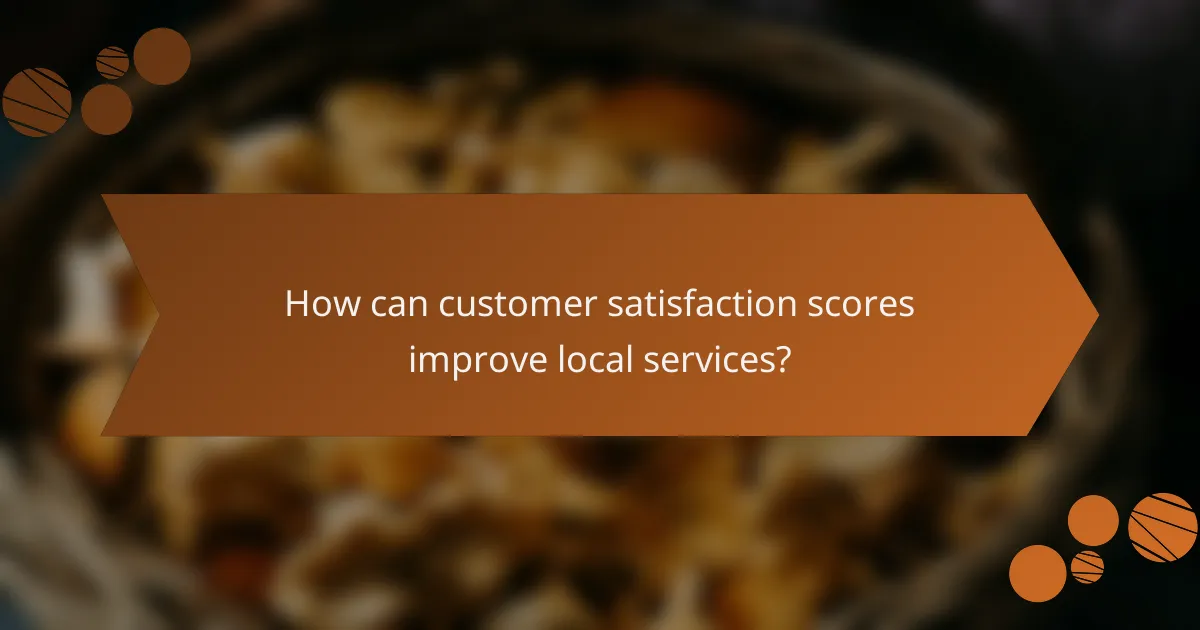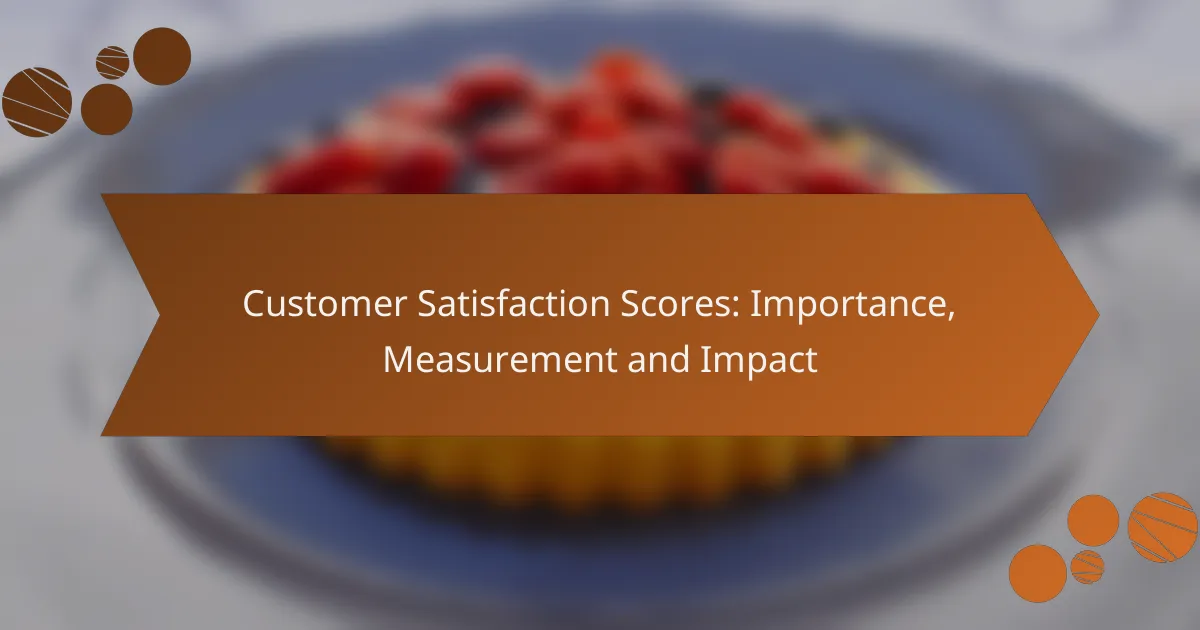Customer satisfaction scores play a crucial role in improving local services by offering valuable insights into customer experiences and expectations. By effectively measuring these scores through methods such as surveys and the Net Promoter Score, businesses can pinpoint areas for enhancement, ultimately leading to better service delivery and increased customer loyalty.

How can customer satisfaction scores improve local services?
Customer satisfaction scores are vital for enhancing local services as they provide insights into customer experiences and expectations. By analyzing these scores, businesses can identify areas for improvement, leading to better service delivery and increased customer retention.
Enhanced customer loyalty
High customer satisfaction scores often correlate with increased loyalty. When customers feel valued and their needs are met, they are more likely to return for repeat business. For local services, this means building a loyal customer base that prefers your offerings over competitors.
To foster loyalty, businesses should regularly solicit feedback and act on it. Simple practices like personalized communication and loyalty programs can significantly enhance customer retention.
Increased referrals
Customers who are satisfied with local services are more inclined to recommend them to friends and family. Positive word-of-mouth can be a powerful marketing tool, especially in tight-knit communities. Satisfied customers often share their experiences on social media, amplifying your reach.
Encouraging referrals can be as simple as asking satisfied customers to share their experiences or offering incentives for referrals. This can lead to a steady stream of new clients without significant marketing costs.
Better service quality
Customer satisfaction scores provide direct feedback on service quality, highlighting strengths and weaknesses. By analyzing this data, businesses can implement targeted improvements, leading to enhanced service delivery. For instance, if scores indicate long wait times, addressing staffing or process issues can significantly improve customer experiences.
Regularly reviewing satisfaction scores allows businesses to adapt to changing customer expectations and maintain high service standards. This proactive approach can differentiate local services in competitive markets.
Higher revenue growth
Improving customer satisfaction can lead to higher revenue growth as satisfied customers tend to spend more. Research shows that businesses with high satisfaction scores often see increased sales and profitability. For local services, this translates into a more robust financial performance.
To maximize revenue growth, focus on enhancing customer experiences through quality service, effective communication, and addressing feedback promptly. This not only boosts satisfaction but also encourages higher spending per visit.

What methods are used to measure customer satisfaction scores?
Customer satisfaction scores can be measured using various methods that provide insights into customer experiences and perceptions. Common approaches include surveys, Net Promoter Score (NPS), Customer Satisfaction Score (CSAT), and Customer Effort Score (CES), each offering unique advantages for understanding customer sentiment.
Surveys and questionnaires
Surveys and questionnaires are direct tools for gathering customer feedback on their experiences. They can be distributed via email, online platforms, or in-person, allowing businesses to collect quantitative and qualitative data. Effective surveys typically include a mix of closed and open-ended questions to capture detailed insights.
When designing surveys, keep them concise and focused to encourage higher response rates. Aim for a completion time of under 5 minutes to respect customers’ time. Consider using a Likert scale for questions to quantify satisfaction levels easily.
Net Promoter Score (NPS)
The Net Promoter Score (NPS) measures customer loyalty by asking a single question: “On a scale from 0 to 10, how likely are you to recommend our product/service to a friend or colleague?” This method categorizes respondents into promoters, passives, and detractors, providing a clear snapshot of customer sentiment.
NPS is valuable for benchmarking against industry standards and tracking changes over time. However, it should be supplemented with additional feedback to understand the reasons behind the scores. Regularly analyzing NPS data can help identify areas for improvement.
Customer Satisfaction Score (CSAT)
The Customer Satisfaction Score (CSAT) gauges customer satisfaction with a specific interaction or overall experience. Typically measured through a straightforward question, such as “How satisfied were you with your experience?” CSAT scores are often collected immediately after a service interaction.
CSAT is useful for pinpointing strengths and weaknesses in customer service. A common practice is to use a scale from 1 to 5 or 1 to 10, where higher scores indicate greater satisfaction. Businesses should aim for a CSAT score above 80% to indicate a positive customer experience.
Customer Effort Score (CES)
The Customer Effort Score (CES) assesses how easy it is for customers to interact with a company or resolve issues. It typically asks customers to rate their effort on a scale, such as “How easy was it to get your issue resolved?” This metric helps identify friction points in the customer journey.
CES is particularly useful for improving processes and reducing customer effort. A lower effort score correlates with higher customer satisfaction and loyalty. Companies should focus on minimizing customer effort by streamlining processes and providing clear guidance during interactions.

What factors influence customer satisfaction scores in local services?
Customer satisfaction scores in local services are influenced by various factors, including service quality, response time, employee engagement, and pricing transparency. Understanding these elements helps businesses enhance their offerings and improve overall customer experiences.
Service quality
Service quality is a critical determinant of customer satisfaction scores. It encompasses the reliability, assurance, and empathy provided by service personnel. High-quality service often leads to positive experiences, encouraging repeat business and referrals.
To assess service quality, consider implementing customer feedback mechanisms such as surveys or reviews. Aim for a consistent standard across all interactions to maintain high satisfaction levels.
Response time
Response time significantly impacts customer satisfaction, as quick resolutions to inquiries or issues can enhance the overall experience. Customers generally expect responses within a few minutes to a couple of hours, depending on the service type.
To improve response time, establish clear protocols for handling customer inquiries and invest in training staff to prioritize timely communication. Utilizing automated systems for initial responses can also help meet customer expectations effectively.
Employee engagement
Employee engagement directly correlates with customer satisfaction scores. Engaged employees are more likely to provide exceptional service, fostering positive interactions with customers. This can lead to higher satisfaction and loyalty rates.
Encourage employee engagement through regular training, recognition programs, and open communication channels. A motivated workforce often translates to a better customer experience.
Pricing transparency
Pricing transparency is essential for building trust and satisfaction among customers. Clear communication about costs, fees, and any potential additional charges can prevent misunderstandings and dissatisfaction.
To enhance pricing transparency, provide detailed pricing information on your website and during customer interactions. Avoid hidden fees and ensure that customers feel informed about their financial commitments, which can lead to improved satisfaction and loyalty.

How do customer satisfaction scores impact business decisions?
Customer satisfaction scores significantly influence business decisions by providing insights into customer perceptions and preferences. These scores help companies identify strengths and weaknesses in their offerings, guiding strategic adjustments to improve overall performance.
Guiding service improvements
Customer satisfaction scores serve as a critical tool for guiding service improvements. By analyzing feedback, businesses can pinpoint specific areas where service delivery may fall short, allowing them to implement targeted enhancements. For instance, if scores indicate long wait times, a company might invest in additional staff or technology to streamline service.
Regularly tracking these scores ensures that improvements align with customer expectations, fostering a culture of continuous enhancement. Companies should consider using a mix of qualitative and quantitative feedback to gain a comprehensive understanding of service gaps.
Influencing marketing strategies
High customer satisfaction scores can significantly shape marketing strategies by highlighting what resonates with customers. Businesses can leverage positive feedback in their promotional materials, showcasing testimonials or case studies that reflect customer satisfaction. This approach not only builds credibility but also attracts new customers who value positive experiences.
Conversely, low satisfaction scores may prompt a reevaluation of marketing messages or target audiences. Companies should analyze the reasons behind the scores and adjust their strategies accordingly, ensuring that marketing efforts align with customer needs and preferences.
Shaping customer experience initiatives
Customer satisfaction scores play a vital role in shaping customer experience initiatives. By understanding what drives satisfaction, businesses can create tailored experiences that meet or exceed customer expectations. For example, if feedback suggests that personalization enhances satisfaction, companies might implement personalized communication strategies or customized product offerings.
Additionally, organizations should consider establishing a feedback loop where customer insights directly inform experience initiatives. This proactive approach not only improves satisfaction but also fosters customer loyalty, as customers feel valued and heard in the decision-making process.

What are the best practices for improving customer satisfaction scores?
Improving customer satisfaction scores involves implementing strategies that enhance the overall customer experience. Key practices include regularly collecting feedback, personalizing interactions, and effectively training staff to meet customer needs.
Regular feedback collection
Consistent feedback collection is essential for understanding customer sentiments and identifying areas for improvement. Utilize surveys, focus groups, and online reviews to gather insights on customer experiences.
Consider using tools like Net Promoter Score (NPS) or Customer Satisfaction Score (CSAT) to quantify feedback. Aim to collect feedback after significant interactions, such as purchases or support calls, to get timely and relevant data.
Personalized customer interactions
Personalizing customer interactions can significantly enhance satisfaction scores. Tailor communications and services based on customer preferences and past behaviors to create a more engaging experience.
Use customer relationship management (CRM) systems to track interactions and preferences. Simple gestures, like addressing customers by name or recommending products based on previous purchases, can foster loyalty and satisfaction.
Training staff effectively
Effective staff training is crucial for delivering high-quality customer service. Equip employees with the skills and knowledge to handle inquiries and resolve issues promptly and empathetically.
Implement ongoing training programs that focus on product knowledge, communication skills, and conflict resolution. Encourage role-playing scenarios to prepare staff for real-life situations, ensuring they feel confident in their ability to meet customer needs.
